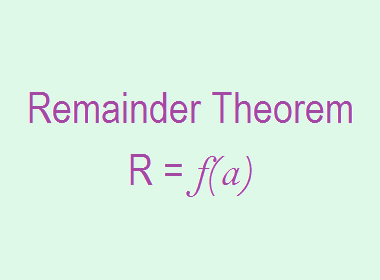Remainder Theorem
The remainder theorem states that - when
a polynomial f(x) is divided by a binomial x – a, then the remainder is f(a).
********************
10 Math Problems officially announces the release of Quick Math Solver and 10 Math Problems, Apps on Google Play Store for students around the world.
********************
********************
Proof: If we divide a polynomial f(x) by a binomial x – a, then we get Q(x) as quotient and R as remainder. Then,
f(x) = (x – a).Q(x) + R
Putting
x = a, then
f(a)
= (a – a).Q(x) + R
or, f(a) = 0 + R
or, R = f(a)
Hence,
the remainder R = f(a). Proved.
Corollary 1: If a polynomial f(x) is divided by (x + a), then
the remainder R = f(-a).
Proof: If we divide f(x) by (x +
a), then we get Q(x) as quotient and R as remainder. Then,
f(x)
= (x + a).Q(x) + R
Putting
x = -a, then
f(-a)
= (-a + a).Q(x) + R
or, f(-a) = 0 + R
or, R = f(-a)
Hence,
the remainder R = f(-a). Proved
Corollary 2: If a polynomial f(x) is divided by (ax + b), then
the remainder R = f(-b/a).
Proof: When we divide f(x) by ax +
b, then we get Q(x) as quotient and R as remainder. Then,
f(x)
= (ax + b).Q(x) + R = a(x + b/a).Q(x) + R
Putting
x = -b/a, then
f(-b/a)
= a(-b/a + b/a).Q(x) + R
or, f(-b/a) = 0 + R
or,
R = f(-b/a)
Hence,
the remainder R = f(-b/a). Proved.
Corollary 3: If a polynomial f(x) is divided by (ax – b), then
the remainder R = f(b/a).
Proof: When we divide f(x) by ax –
b, then we get Q(x) as quotient and R as remainder. Then,
f(x)
= (ax – b).Q(x) + R = a(x – b/a).Q(x) + R
Putting
x = b/a, then
f(b/a)
= a(b/a – b/a).Q(x) + R
or, f(b/a) = 0 + R
or,
R = f(b/a)
Hence,
the remainder R = f(b/a). Proved.
Workout Examples
Example 1: Find the remainder when x3
– 4x2 + 8x – 5 is divided by x – 2.
Solution: Here,
f(x) = x3 –
4x2 + 8x – 5
Comparing x – 2 with x
– a, a = 2
∴ by remainder theorem,
Remainder
R = f(2)
= 23 - 4×22 + 8 ×
2 – 5
= 8 – 16 + 16 – 5
= 3
Example 2: Find the remainder when 4x3
+ 2x2 – 4x + 3 is divided by 2x + 3.
Solution: Here,
f(x) = 4x3 +
2x2 – 4x + 3
Divisor 2x + 3 can be
written as 2(x + 3/2) and comparing with x – a, a = -3/2
∴ by remainder theorem,
Remainder
R = f(-3/2)
= 4×(-3/2)3 + 2×(-3/2)2
– 4 ×
(-3/2) + 3
= 4×-27/8 + 9/2 + 6 + 3
= -27/2 + 9/2 + 9
= 0
Example 3: When a polynomial x3
– 3x2 + mx + m is divided by x + 2, a remainder -2m is obtained,
find the value of m.
Solution: Here,
f(x) = x3 – 3x2
+ mx + m
Comparing x + 2 with x
– a, a = -2
∴ by remainder theorem,
f(-2)
= Remainder
i.e (–2)3 – 3×(–2)2 + m ×
(–2) + m = –2m
or, –20 – m
= –2m
or, –m + 2m = 20
or, m = 20
∴ The value of m = 20.
You can comment your questions or problems regarding the remainder theorem here.




0 comments: